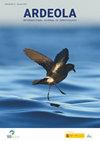How Habitat Features and Human Activities Shape Occurrence of the Declining Eurasian Oystercatcher Haematopus ostralegus on a Mediterranean Coastline
IF 1.2
4区 生物学
Q2 ORNITHOLOGY
引用次数: 2
Abstract
Summary. Understanding ecological factors and processes affecting the abundance of species of conservation concern is key to ensuring their conservation. The Eurasian Oystercatcher Haematopus ostralegus is a ‘Near Threatened’ wader species that depends on coastal zones during the non-breeding season. However, these habitats constitute focal points of human settlement and suffer from intensified human activities. I used survey data from the central part of the Gulf of Gabès, Tunisia, to assess the significance of ecological and anthropogenic factors as predictors of the density of wintering oystercatchers. Using generalized linear mixed models, Oystercatcher density was positively correlated with sediment mud content and negatively correlated with seagrass cover. Density was also positively correlated with distance from human settlements and negatively correlated with the densities of recreationists and artisanal fishermen. Overall, oystercatchers avoid intertidal areas near human settlements. This study provides critical information on where conservation and research efforts should be focused to preserve this wader species. As a priority, investigations on flight initiation distances are needed to determine at which spatial level it would be beneficial to create buffer zones or walkways to minimise the negative impact of human disturbance on this wintering population.— Hamza, F. (2020). How habitat features and human activities shape occurrence of the declining Eurasian Oystercatcher Haematopus ostralegus on a Mediterranean coastline. Ardeola, 67: 269-284.生境特征和人类活动如何影响地中海沿岸欧亚捕牡蛎者ostraleghaematopus的发生
总结。了解影响受保护物种丰度的生态因素和过程是确保它们得到保护的关键。欧亚捕牡蛎者ostralegus是一种“近危”涉水物种,在非繁殖季节依赖于沿海地区。然而,这些生境是人类住区的焦点,并受到人类活动加剧的影响。我使用了来自突尼斯加布特斯湾中部的调查数据,以评估生态和人为因素作为冬捕牡蛎者密度预测因子的重要性。在广义线性混合模型下,捕牡蛎密度与泥沙含量正相关,与海草盖度负相关。密度与人类住区的距离呈正相关,与游憩者和手工渔民的密度呈负相关。总的来说,捕牡蛎者会避开人类住区附近的潮间带。这项研究为保护这一涉水物种的保护和研究工作应该集中在哪里提供了关键信息。首先,需要对飞行起始距离进行调查,以确定在哪个空间水平上创建缓冲区或人行道是有益的,以尽量减少人类干扰对这些越冬种群的负面影响。——哈姆扎F. (2020)栖息地特征和人类活动如何影响地中海海岸线上欧亚捕牡蛎者ostralegus数量的下降。中国生物医学工程学报,27(6):269-284。
本文章由计算机程序翻译,如有差异,请以英文原文为准。
求助全文
约1分钟内获得全文
求助全文
来源期刊
CiteScore
2.30
自引率
6.20%
发文量
16
审稿时长
>12 weeks
期刊介绍:
Ardeola: International Journal of Ornithology is the scientific journal of SEO/BirdLife, the Spanish Ornithological Society. The journal had a regional focus when it was first published, in 1954. Since then, and particular during the past two decades, the journal has expanded its thematic and geographical scope. It is now a fully international forum for research on all aspects of ornithology. We thus welcome studies within the fields of basic biology, ecology, behaviour, conservation and biogeography, especially those arising from hypothesis-based research. Although we have a long publication history of Mediterranean and Neotropical studies, we accept papers on investigations worldwide.
Each volume of Ardeola has two parts, published annually in January and July. The main body of each issue comprises full-length original articles (Papersand Review articles) and shorter notes on methodology or stimulating findings (Short Communications). The publication language is English, with summaries, figure legends and table captions also in Spanish. Ardeolaalso publishes critical Book Reviewsand PhD-Dissertation Summaries; summarising ornithological theses defended in Spain. Finally there are two Spanish-language sections, Ornithological News; summarising significant recent observations of birds in Spain, and Observations of Rare Birds in Spain, the annual reports of the Spanish Rarities Committee.

 求助内容:
求助内容: 应助结果提醒方式:
应助结果提醒方式:


